RED DEER – Alberta may delay mandatory cattle age verification until 2007.
However, pressure from international customers for traceback and proof of age makes it necessary for Canada’s largest beef-producing province to stay on track, said Alberta agriculture minister Doug Horner.
“Plan on it being in 2007. If we can’t achieve that then we will have to revisit that, but if it puts us three years ahead of the U.S., then that’s a benefit to you,” said Horner at the Alberta beef industry conference in Red Deer Feb. 18.
Read Also

Manitoba extends Crown land rent freeze
Manitoba government links the continued rental rate freeze on grazing and forage leases to economic and environmental challenges facing the industry
The provincial agriculture department has been instructed to work with producers and the Canadian Cattle Identification Agency to make sure the verification process has legitimacy.
“If there is a place anywhere in the world to get ahead of the wave, it’s us. The reason we went mandatory is because the international community was telling us they wanted some government involvement to ensure integrity in the system,” he said.
Money has been set aside in the agriculture budget to make the transition to mandatory age verification.
Other provincial jurisdictions are looking at mandatory age verification seriously because of the positive responses received from international customers.
One American market analyst at the conference said the United States Department of Agriculture cannot make its individual identification program mandatory. It has announced it could have a voluntary program running by 2009.
“They do not want to pay for it or regulate it,” said Tom Hogan of Snappy Jack Cattle Co. in Georgia.
Corporations like the McDonald’s restaurant chain may drive it instead.
The U.S. offered age verification to the Japanese market but since that trade closed last month, there is little incentive to comply, he said.
Large operators are also reluctant to comply and since the domestic market can absorb everything the U.S. produces, they see little reason to move forward.
The U.S. also has a number of small producers running 100 cows or less. Most have off-farm jobs and do not depend on cattle for their primary income. Locating these herds is difficult and many say they cannot afford the ID program.
“I don’t think we’ll ever get that bottom 20 percentile,” Hogan said.















